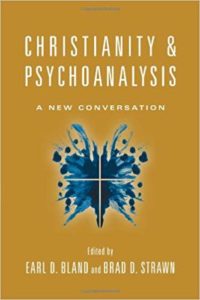
Christianity and Psychoanalysis: A New Conversation
Reviewed by J. P. Gerber, Psychology, Gordon College
This book is the first volume from the recently formed Society for the Exploration of Psychoanalytic Therapies and Theology. It seeks to refresh writing on psychoanalytic therapy by engaging a wide range of scholars and practitioners from diverse corners of the psychoanalytic landscape. It also attempts to deepen the role of theology in psychoanalysis by employing a traditional approach in which authors explore the distinctives of their particular Christian tradition. Eight integrations of different relational schools and different Christian traditions are then applied to a case study of Tony, a post-college male exhibiting problems with close relationships (conflict and distance with parents, romantic partners, and friends), sexual difficulties (including semi-public auto-eroticism), and a sense of purposelessness in life and disconnection from God.
Several of the chapters are highly engaging and informative, and I would recommend the book to those interested in psychoanalysis and faith on the basis of those chapters alone. Lowell Hoffman, one of the co-founders of the SEPTT group and their training institute (BIPACT), provides an authoritative and erudite exposition of relational psychoanalysis and the approach of the SEPTT group. Theresa Tisdale’s analysis of the British middle school is insightful and highlights the role religion has played in that movement. The book also covers the breadth of perspectives in psychoanalysis, from classical Freudian therapy to Kohutian and other eclectic relational turns and even self-psychology, along with some excellent extensions to attachment theory and couples therapy.
This work is necessitated both by a need for deeper integration of Christianity and psychoanalysis and by a desire to get out of an impasse in the psychoanalytic landscape. Psychoanalysis, both now and historically, has been fragmented regarding to what we should pay attention, particularly with respect to treatment. For example, Jacques Lacan’s ejection from the Société Parisienne de Psychanalyse in 1953 was due to Lacan’s use of variable-length therapy sessions. Lacan, at this stage, was paying attention to one thing, the transformative moment of recognition, when people begin to access those pages of their story that were not available to consciousness. As long as this occurred, Lacan believed therapy was progressing. This led to a change in praxis, the variable-length session, and an eventual split with his parent organization. Splits between Sigmund Freud and Carl Jung and between various members of the British school can also be reasonably construed along these lines.1
But is this true today? Do different schools actually look at different aspects of theory and practice?2 In other words, does this book give different recommendations for addressing the problems Tony is facing? Indeed it does. Wesleyan classical Freudian theory (chapter 3) suggests problems with his mother, competition with his father, and subsequent defensive mechanisms of distancing from other males and females. The underlying motives for these would be explored along with the reasons for the compromise formations that allow Tony to gratify his sexual urges partially while ignoring the underlying urges. Along with these insights, classical theory expects transference of Tony’s parental problems onto the therapist. Ecumenical Catholic objects relation theory (chapter 4) suggests Tony has a false sense of self, lacking in options for ways to relate, and needs new ways to relate to others (starting with the therapist), hopefully leading to relating to God.
Pentecostal Kohutian self-therapy (chapter 5) focuses upon understanding the inner experience of the patient, suggesting empathy will help Tony along. The unique contribution of faith here is that empathy from the therapist is best when expressing God’s love and grace. Incarnational (Messianic Jewish) intersubjective systems theory (chapter 6) maintains we are fundamentally relational, not Cartesianally alone, and hence therapy should focus on interpersonal affects, not individual drives. It also notes that Christians can push immediate submission instead of fully experiencing an affect and then surrendering it to God. While undergoing this process, Tony needs to find appropriate distance from both parents (differentiating from his mother and increasing relationship with his dad), and hopefully find, from this change, a new way to relate to God.
Reformed relational psychoanalysis (chapter 7) is eclectic, and offers suggestions similar to others: we are truly socially motivated, and most things that might be considered pathological are probably reasonable defenses. This approach would encourage Tony to stop lying on the couch and engage in a relationship, while being on the alert to notice transferences and find a way to step outside them to bring change.
Trinitarian attachment theory (chapter 8) has largely the same outcomes as intersubjective systems theory. According to this approach, Tony needs to understand his attachment style (most likely pre-occupied) and then to experience emotions and regulate them with the help of others.
Couples therapy (chapter 9) understandably has nothing to say to Tony, and brief psychotherapy (chapter 10), wants to do what some of the authors of the previous chapters suggest, just more quickly.
Given the variety of foci and issues to address, we can see the value in a broad new conversation among Christian psychoanalysts. In what ways might this conversation be enlarged? First, at least two other significant figures in the history of psychology need to be brought into the conversation: Jacques Lacan and Oskar Pfister. Jacques Lacan’s absence is sorely lacking in this book, when discussing many issues, including Freud’s statement “where the ego was, I must become” (67), the nature of intersubjectivity, and the reasons for brief therapy. It also seems strange to have a book that integrates people’s own history in faith and therapeutic technique and not to discuss Lacan’s view that all therapy (and indeed this book) might be the current construction of each author’s own history.
A second figure lacking in this book is Oscar Pfister, a Swiss pastor and psychoanalytic writer who actively corresponded with Freud over a number of decades. This lack is devastating given that Pfister (and Jung) criticized psychoanalysis for lacking moral imperatives, and subsequent developments in psychoanalysis (for example, inter-subjective systems theory) crucially fail to overcome this objection. It is good to see at least one of the authors note that psychoanalysis has a weak moral imperative, but reference to the history of this critique could create more depth.
The second way in which Christians might enlarge their conversation on this topic is to refuse to be doctrinaire in our thinking about intersubjectivity and irreducibility. The constructionist argument suggests that all perspectives are equally valid because there is a hermeneutical circle that cannot be broken. The book swallows this argument, particularly with respect to the application of it to the irreducibility of the therapist. The argument says that each therapist has his or her own perspective, and therapy is intersubjective, hence we cannot actually remove the influence of the therapist. Instead, the therapist merely needs to abandon any notion of objectivity and own their perspective.
There are many problems with this argument. First, the purported irreducibility of the therapist is betrayed by the use of trainee analysis. Since the dawn of psychoanalysis, the training of therapists has involved them being analyzed by a more senior therapist, in order to elucidate the trainee’s own transferences. This work helps reduce the influence of the therapist in therapy, while acknowledging the intersubjective nature of therapy.3 While the perspective of the therapist can never be abandoned, it can be greatly reduced.
A further problem with the idea of irreducibility is that the very process of writing a book about reconciling different perspectives in psychoanalysis and faith implies comparability of perspectives. Comparability, in turn, makes judgment possible.
Perhaps irreducibility is reliant on a strict dichotomy between objective and subjective, such that anything that is not totally objective is subjective. This seems like a false dichotomy. One does not need perfect knowledge to have more or less objective knowledge. In the same way that the nature/nurture debate moved from an either perspective to a variance-based and then interactionist perspective, and causal inference did too, it is time for psychoanalytic theory to own that the therapeutic process is partially objective and partially subjective.
Given these considerations, it is not enough to acknowledge that we are people-in-context and that models are shaped by our context. The wisest are those who have read broadly enough that they are less limited in their horizons, see from multiple perspectives, recognize the truth across those perspectives, and act in a way that brings about change. Our viewpoint may be ineradicable, but it is still reducible.4
Two further minor points of conversational enlargement remain. First, Warren Heard (1993) argued that the Christian hope of heaven breaks the hermeneutical circle by giving psychology a future orientation, and a faith-filled psychoanalysis needs to break with the past-orientation underlying Freud’s determinism. Teleology gives meaning and ultimate perspective. Second, Christian psychoanalysts could enlarge their own conversation by thinking more clearly about the nature of emergence. At the moment, the key marker of emergence is that a human recognizes it. This seems like a rather weak measurement model. Given the sizable theological heritage that we can bring to such a question, it seems reasonable to ask Christians to define more clearly than others the nature of emergence.
Overall, this book does its job of opening a new conversation, and I hope to see it address other issues that need further conversation.
Cite this article
Footnotes
- The letters between Freud and Oskar Pfister concerning the Swiss psychoanalytic movement share a similar concern over the focus of attention in therapy.
- We can consider Kurt Lewin’s famous dictum: there is nothing so practical as a good theory, and nothing so theoretical as good practice. One implication of this dictum is that, should practical applications be identical, theoretical differences are merely a matter of terminology.
- This is similar in concept to any covariance model of causal inference from social psychology. As we see the same person in many situations, we can start to separate out unique parts of them from parts of the situation. The analogy for therapy is that as the same therapist interacts with people and other therapists, they learn about themselves.
- A point implied by Hoffman’s ‘analytic third,’ where we can step outside the immediate transference relationship.




















